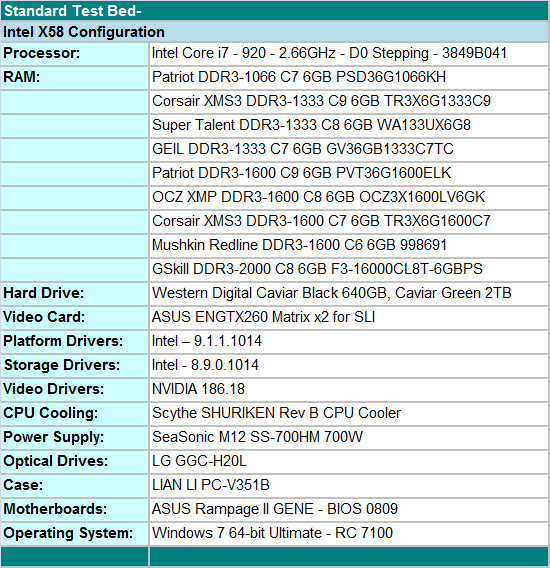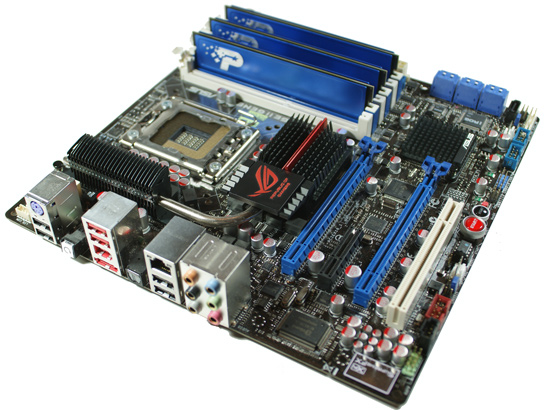Memory Scaling on Core i7 - Is DDR3-1066 Really the Best Choice?
by Gary Key on June 24, 2009 9:00 AM EST- Posted in
- Memory
The Test

We decided to build an i7 uATX system for testing today. We certainly had our pick of various components for a memory test bed with the EVGA Classified, Gigabyte X58 Extreme, and DFI UT X58 boards coming to mind along with higher end video card and storage selections. In the end, we decided taking a practical approach to the component selection would serve us better in showing memory results on a system considered mid-range in the i7 world from a performance viewpoint. We will follow up shortly to see what differences occur in memory performance when utilizing an SSD, different memory/board timings, and additional benchmarks with Virtualization routines.
We settled on the ASUS Rampage II GENE as our motherboard choice based on the available feature set and BIOS options. You could certainly cost reduce this system and utilize the excellent MSI X58M motherboard. Our processor choice was easy as the Core i7 920 is the best selling i7 product and represents what most users currently pair with an X58 board.
We selected the ASUS ENGTX260 video card for GPU duties. It is a non-reference design that offers improved thermals and acoustics over the standard NVIDIA GTX 260 216 designs. The WD Caviar Black 640GB is our hard drive of choice for primary storage purposes with the WD Caviar Green 2TB drive as a logical choice for backup duty. LG’s GGC-H20L Blu-ray playback capable drives fills in for optical duties.
We purchased several 6GB kits for memory duties. We set the BIOS to the advertised settings for each kit on the primary timings and left the sub-timings on auto in the BIOS. Of course, those who like to play around in the BIOS could certainly improve upon our synthetic results but overall, we found very little if any differences in actual applications when tuning the sub-timings.
We chose the Scythe SHURIKEN Rev B CPU Cooler for air-cooling duties. This cooler features a low profile design with quiet operation and good cooling characteristics, which is perfect for a base SFF setup. For the more performance oriented crowd we highly suggest the Thermalright AXP-140 with a Thermaltake 140mm fan. We are currently testing this combination for a uATX shootout and it works well.
Our standard power supply is the excellent SeaSonic M12 SS700HM 700W modular unit. This power supply also works for SLI/CF testing since it supports the necessary PCIe connectors. LIN LI’s PC-V351B turned out to be an excellent choice for this setup although our loaded system was cramped for space. We had to complete some creative engineering for all the cooling systems to work properly while taming cable management obstacles. We utilized the ASUS VH242H 23.6" 1920x1080 LCD monitor for display duties. Finally, we have dropped Vista 64-bit and moved to Windows 7 Ultimate 64-bit for our testing today - it just works better.

Our software choices represent a wide variety of applications and we selected 64-bit versions of the program where applicable to ensure full access to our 6GB memory configuration. Unless otherwise noted, we run each benchmark three times and average the results for our score. We clear the prefetch folder between each test run, defrag, and then reboot when switching to a new benchmark. Our programs are updated to the latest release from the supplier. Turbo mode along with HT is enabled on the Core i7 920 and power management is set to balanced for testing.










47 Comments
View All Comments
sonci - Thursday, June 25, 2009 - link
The title was enough,and yours is too..
goinginstyle - Wednesday, June 24, 2009 - link
I have no idea where you have been hiding Gary but it is great to see you back. I look forward to the AMD article and the individual module tests. If they are half as good as this, I will be one happy person. Any chance or comments on Virtualization benches under WIn7 with XP?duploxxx - Wednesday, June 24, 2009 - link
very nice article with real world applications, now can you pls do the same with amount of dimms used and finally kill this marketing hype?vailr - Wednesday, June 24, 2009 - link
Re:"Current JDEC specifications list 1.50V as the official voltage specification for DDR3 with a move to 1.35V in the near future and eventually to 1.20V."
How does DDR5 (already being used on some video cards) voltages compare with those numbers?
Any predictions on when DDR5 memory modules for main boards might be introduced?
Are lower latency DDR3 modules "in the works"?
Maybe such a thing as:
1333 MHz @4-4-4-12 & 1.20v, for example?
Also: Intel promotes the benefits of using Hafnium when producing their CPU's. Would Hafnium also benefit memory chips?
GourdFreeMan - Thursday, June 25, 2009 - link
The video cards you are thinking of use GDDR, not DDR. You will never find GDDR packaged on DIMMs for motherboard memory slots, but rather only as individual chips for graphics boards and consoles. Though they share some technologies, you would need a different memory controller to make use of it. Typically GDDR5 runs from 1V to 1.4V (the GDDR5 on the stock Radeon HD 4770 runs at 1.263V for example). Hafnium dioxide has already been used by some manufacturers as the dielectric material in DRAM capacitors, and I know NEC, at least, has already used Hafnium in transistor gates for embedded DRAM. As for higher speed and lower latency RAM, that is pretty much always in the works...Zorlac - Wednesday, June 24, 2009 - link
I have thought this all along, but was too lazy to prove it. Thanks Anand!!! :)Any idea when we will start seeing 4GB DIMMs for running 3x4GB kits?
Gary Key - Wednesday, June 24, 2009 - link
We just finished testing a 12GB 1600 C9 kit from Kingston, but the street price is $1400. I also have a 24GB kit from Corsair, but I will not even mention the cost on that one. We should see affordable (compared to buying 6x2GB) 12GB kits later this year in the 1333 C8 variety without ECC. I do have a 12GB ECC Kingston 1066 C8 kit arriving shortly, retail is about $320, to test in some workstation products.DXRick - Wednesday, June 24, 2009 - link
It looks like the sweet spot is 1600 C8 at around $100 for a 6BG kit.vol7ron - Wednesday, June 24, 2009 - link
agreed --- those saying 1333 really are saving the buckI would still like to see SuperPi tests, since they are a mathematical approach to memory performance.
Gary Key - Wednesday, June 24, 2009 - link
Super Pi results will come in Raja's 2000 shootout. However, most of the Super Pi program runs in cache and when it goes outside of it,it only hits a couple of ranks in short bursts (why bandwidth matters) and as a result a proper loading of the entire memory subsystem is not really tested thoroughly. That said, we will have a complete subsection on Super Pi for the overclocking crowd. :)